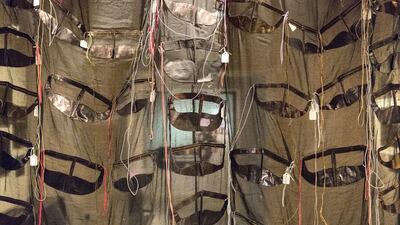It is a thing of immense, cultural beauty. The burqa, says multimedia artist Dr Karima Alshomely, is a frame confronting the eyes, which directly reflect the human soul. Its place in UAE heritage cannot be contested.
It is this passion for an item she believes to be both intimate and essential to understanding Emirati women – an important social and historical icon for the UAE – that has driven Alshomely to present her exhibition, The Emirati Burqa: An Intimate Object.
On display at the Sharjah Heritage Museum until June 4, the exhibition – a fresh and contemporary take on a historical icon – features photographs, paintings, installations and films. The art is both gritty and gripping, and stems from Alshomely's memories and relationship with the burqa, and her interpretation of its history.
“I perceive the burqa to be an intimate object,” says Alshomely, who is an assistant professor at the College of Fine Arts and Design at the University of Sharjah. “As a material object, an item of dress, an accessory or a marker of status, the burqa can be seen as a thing in the world that exists outside of the individual subject. Yet, as this artwork shows, the burqa has been part of Emirati women’s social and cultural identity and it is also deeply personal to each individual woman.”
On the one hand, the exhibition aims to preserve Emirati heritage and encourage visitors to see the burqa as more than just an item of traditional dress. On the other, Alshomely wants people to understand that not every burqa is created equal: it has always been deeply personal to each wearer.
“The burqa is a visual text that authors the silent memoir of the face,” explains Alshomely. “It allows the onlookers a unique access to a world that highlights the daily life and rituals of the burqa owner. It displays the beliefs associated with the practice of burqa wearing and its rituals, some of which remain as they were with the addition of modern adjustments.”
These modern adjustments are juxtaposed to the historical context. Alshomely uses multiple forms of artistic and visual media to present her message, including materials and construction, various burqa wearing practices, installations on the loss and recovery of the garment and even the smells associated with it. There’s a map of the UAE and the region dotted with various burqa shapes to show how the garment’s shapes differ according to each area. A series of photographs also present stages of putting on a burqa.
Photographs of a burqa half-submerged on a beach with waves lapping at its edges represent its disappearance from Emirati life; watercolour paintings of various burqa shapes; framed examples of the packaging burqas came in; a perfectly curated collection of old metal and tin boxes that contained sweets from decades ago – now filled with the nostalgia of old burqas and the materials used to make them; and a multidimensional photograph of a bride, taken from several angles, hiding behind her burqa and reflecting on her coming wedding.
“With the content’s solid presence, I stress the importance of the emotional charge that intensifies at the meeting point with this artifact I present for display,” says Alshomely.
For her, the burqa is an advanced form of expression towards physical and intellectual potential, and launches the aesthetics of the face. The cotton cloth is saturated with indigo dye and can wholly or partially cover the face apart from the eyes. Once considered an item of traditional everyday dress for most Emirati women until the late 1960s, it is worn less these days and is seen as an old fashioned way of dress.
As for the “intimate” side of the exhibit, Alshomely says she was fascinated by her grandmother’s burqa. Although she and her mother never wore one, her grandmother, who came to stay with the family when Alshomely turned 10, wore it daily. “It completely covered her face except for two small holes that exposed her eyes but hindered her range of vision. I found it fascinating to watch her eat as she carefully lifted up her burqa without revealing her face – she found it difficult, she admitted to me.
“The burqa was her real face to me, it’s the only face I ever saw. One day, when my grandmother was taking a nap, my mother asked me to fetch something from her room. When I entered, I found her sleeping without her burqa on. I was shocked because this sleeping woman was a stranger to me. Her face was covered in wrinkles and most of her front teeth were missing.”
Manal Ataya, director-general of the Sharjah Museums Authority, says these poignant childhood memories are a fascinating glimpse into different views of the burqa. “A visitor to this exhibit will never regard the burqa in the same way again, whether they develop a better understanding of its history and the materials used in its construction or reconsider its place in Emirati society.
“What cannot be doubted is that Karima has taken a functional item of dress and given it a new lease of life as a medium of art.”
Dr Karima Alshomely’s exhibition The Emirati Burqa: An Intimate Object is on display at Sharjah Heritage Museum until June 4
_____________________
Read more:
New desk calendar charts stories of inspirational Emirati women
The nine Emirati Experiences tours and how much they are
Second instalment of Al Ain tour My Old House announced
_____________________

